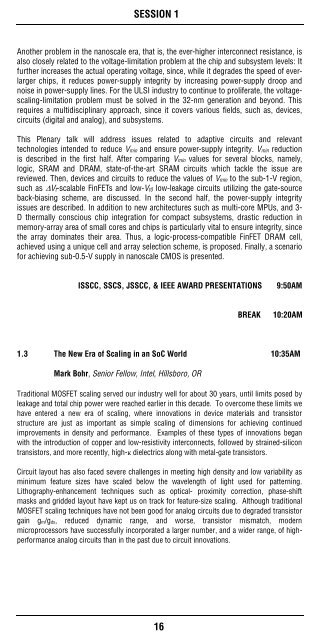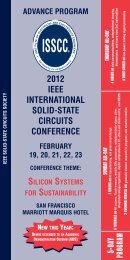Download PDF - International Solid-State Circuits Conference
Download PDF - International Solid-State Circuits Conference
Download PDF - International Solid-State Circuits Conference
You also want an ePaper? Increase the reach of your titles
YUMPU automatically turns print PDFs into web optimized ePapers that Google loves.
SESSION 1<br />
Another problem in the nanoscale era, that is, the ever-higher interconnect resistance, is<br />
also closely related to the voltage-limitation problem at the chip and subsystem levels: It<br />
further increases the actual operating voltage, since, while it degrades the speed of everlarger<br />
chips, it reduces power-supply integrity by increasing power-supply droop and<br />
noise in power-supply lines. For the ULSI industry to continue to proliferate, the voltagescaling-limitation<br />
problem must be solved in the 32-nm generation and beyond. This<br />
requires a multidisciplinary approach, since it covers various fields, such as, devices,<br />
circuits (digital and analog), and subsystems.<br />
This Plenary talk will address issues related to adaptive circuits and relevant<br />
technologies intended to reduce Vmin and ensure power-supply integrity. Vmin reduction<br />
is described in the first half. After comparing Vmin values for several blocks, namely,<br />
logic, SRAM and DRAM, state-of-the-art SRAM circuits which tackle the issue are<br />
reviewed. Then, devices and circuits to reduce the values of Vmin to the sub-1-V region,<br />
such as ∆Vt-scalable FinFETs and low-Vt0 low-leakage circuits utilizing the gate-source<br />
back-biasing scheme, are discussed. In the second half, the power-supply integrity<br />
issues are described. In addition to new architectures such as multi-core MPUs, and 3-<br />
D thermally conscious chip integration for compact subsystems, drastic reduction in<br />
memory-array area of small cores and chips is particularly vital to ensure integrity, since<br />
the array dominates their area. Thus, a logic-process-compatible FinFET DRAM cell,<br />
achieved using a unique cell and array selection scheme, is proposed. Finally, a scenario<br />
for achieving sub-0.5-V supply in nanoscale CMOS is presented.<br />
ISSCC, SSCS, JSSCC, & IEEE AWARD PRESENTATIONS 9:50AM<br />
BREAK 10:20AM<br />
1.3 The New Era of Scaling in an SoC World 10:35AM<br />
Mark Bohr, Senior Fellow, Intel, Hillsboro, OR<br />
Traditional MOSFET scaling served our industry well for about 30 years, until limits posed by<br />
leakage and total chip power were reached earlier in this decade. To overcome these limits we<br />
have entered a new era of scaling, where innovations in device materials and transistor<br />
structure are just as important as simple scaling of dimensions for achieving continued<br />
improvements in density and performance. Examples of these types of innovations began<br />
with the introduction of copper and low-resistivity interconnects, followed by strained-silicon<br />
transistors, and more recently, high-к dielectrics along with metal-gate transistors.<br />
Circuit layout has also faced severe challenges in meeting high density and low variability as<br />
minimum feature sizes have scaled below the wavelength of light used for patterning.<br />
Lithography-enhancement techniques such as optical- proximity correction, phase-shift<br />
masks and gridded layout have kept us on track for feature-size scaling. Although traditional<br />
MOSFET scaling techniques have not been good for analog circuits due to degraded transistor<br />
gain gm/gds, reduced dynamic range, and worse, transistor mismatch, modern<br />
microprocessors have successfully incorporated a larger number, and a wider range, of highperformance<br />
analog circuits than in the past due to circuit innovations.<br />
16




